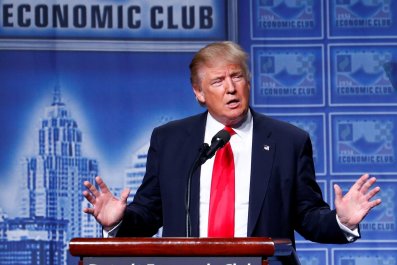When Kelly Dilworth applied for a Discover card in July, she was happy to learn that her spending limit was $13,000—a level most card companies don't offer unless a customer is in the highest credit tier.
Then she found out the card's annual percentage rate (APR) was 21.24 percent, a level that used to be reserved for people with shabby credit. "I was really surprised," says Dilworth. "I had just checked my credit score, and it was excellent. I called Discover to see if I could negotiate a lower interest rate, and they said they would review it in a year. I asked them why my rate was so high, and they couldn't really tell me. They just give you a lot of non-answers."
Like most credit card companies, Discover didn't reveal to Dilworth what her APR would be until after it had issued her card. Dilworth notes she could just cancel the card, but that likely would temporarily hurt her credit score, which is well above 700. Instead, she says, she's keeping the card for its travel rewards. "It's becoming a lot harder to find a regular credit card with a good interest rate," she says, "even if you have good credit."
She isn't your average millennial credit card user. She's been tracking the credit card industry since the Great Recession for CreditCards.com, a credit card marketplace based in Austin, Texas, and knows plenty about how the industry works. What she doesn't understand, however, is why financial institutions are increasingly offering loads of credit but tying it to high APRs—while refusing to offer less extreme options.
Dilworth isn't the only one who's puzzled. While U.S. interest rates remain below 1 percent, some of the same financial institutions allowed to borrow money from the government at historic lows are quietly jacking up rates on even people with commendable credit. This summer, the lowest available APRs offered on new credit cards topped 15 percent on average, marking a five-year high, according to CreditCards.com. (In this anemic market, investors on Wall Street would consider themselves very lucky to make 5 to 10 percent a year—let alone 15 percent or more, as credit card companies do.)
With the Federal Reserve signaling plans to raise interest rates going into next year, experts believe credit card companies will follow, as they did last December. "Rates show no sign of going back down anytime soon," Dilworth says.
While credit card APRs are expected to rise with future rate hikes, they did not plunge with U.S. mortgages and other types of loans when the Fed slashed its rates to nearly zero during the financial crisis. This is partly because, in 2009, Congress introduced a law to restrict the card industry's payment and fee practices, says James Chessen, chief economist for the American Bankers Association. To compensate, card issuers found other ways to profit, by either boosting existing rates or refusing to lower rates on new cards (as with Dilworth).
For the average American credit card user (who holds roughly four open cards), these higher rates are already having an effect: The debt of those carrying balances has risen every quarter since early 2015 and, as of this spring, the average household carrying credit card debt owed more than $16,000—the highest level on record since Congress enacted the credit card reform act.
But rising APRs will hurt millennials the most. They tend to have shorter credit histories and mountains of student loan debt—factors that can weigh heavily on their credit rating, leading to higher interest rates and potentially hurting their ability to pay off monthly balances.
Anthony Copeman, a 25-year-old accountant in Philadelphia, says he's especially sensitive to how his student loan debt might affect his credit score. Like Dilworth, he says it's above 700, but he owes $63,000 in student loans. So far, the credit card offers he gets in the mail from Chase and Discover advertise rates with spreads so wide he can't tell if they're a good deal. "I'd say they usually offer a range of around 15 to 25 percent," he tells Newsweek. "Credit card companies should give us terms that are more black and white, so we know what we're signing up for."
Dilworth says wider spreads have been proliferating over the past few years, with the lowest available rates hardly budging and the upper limits creeping inexorably higher. (Shortly after the credit crisis, one card notoriously offered a rate as high as 79.99 percent, sparking outrage.) As she points out, there are legal limits on certain card fees, but there is no limit on APRs.
No one knows who, if anyone, is being offered the lowest interest rates, Dilworth says, because the credit card industry doesn't need to report that information. "It's really a transparency issue," she says. Such information is even out of reach to the nation's top regulators, says David Robertson, owner and publisher of the Nilson Report, a Carpinteria, California, research firm that tracks the global credit card industry. "What people are really paying and their APR levels, no one knows that. Not even the Federal Reserve."
The upshot? Millennials, who make up the largest population segment in U.S. history, are abandoning credit cards, according to Princeton Survey Research Associates International, a New Jersey consultancy. In a study this year of more than 1,000 people aged 18 to 29—many of whom came of age during the 2008-2009 financial crisis—only 33 percent reported using credit cards. By contrast, 55 percent of those surveyed aged 30 to 49 carried cards, while more than 60 percent of those aged 50 and up carried them.
Erin Lowry, who runs a financial literacy blog, Broke Millennial, says she uses credit cards but avoids the APR trap by paying off her balance every month. Whether the finance industry will be able to win back others in her age group, though, remains to be seen, she says. "A big part of the issue is a distrust of large financial institutions, and I don't know how you PR your way out of that," she tells Newsweek. "Because we grew up with all of that on TV and in the news and were directly impacted by it, it's not going to happen easily."
If credit card companies can't win over millennials, experts say it could very well erode their long-term earnings potential. "This is one of the problems with the industry right now," Robertson says. "It's very profitable, but prospects for growth are dimming."
To make up for lost growth, credit card companies could further raise rates on everyone else. But that approach has pitfalls. In its latest monthly complaints report, the U.S. Consumer Financial Protection Bureau noted that one of the biggest gripes from credit card users is that the industry isn't fair or transparent enough in calculating and assigning APRs. The three companies prompting the most complaints: Bank of America , Wells Fargo and JPMorgan Chase, in that order.
If climbing interest rates are any measure of customer ire—and card companies don't offer more visibility in their decision-making—the number of complaints is likely to rise.
"We haven't seen rates stay this high for this long since the credit crisis," says Dilworth. "With Fed rates so low and going up, I would be surprised if we saw card rates go below 14 percent ever again."




















